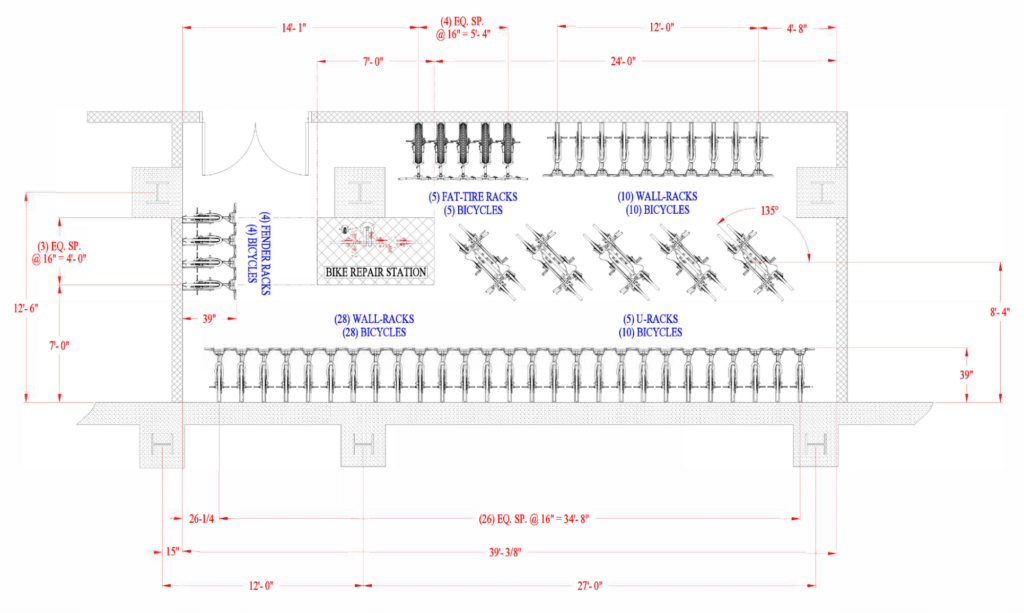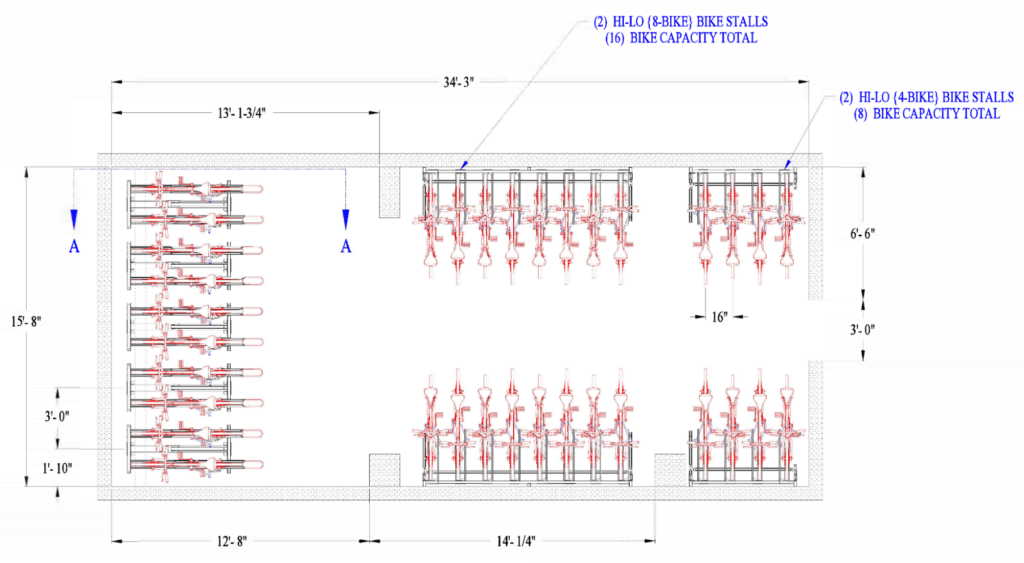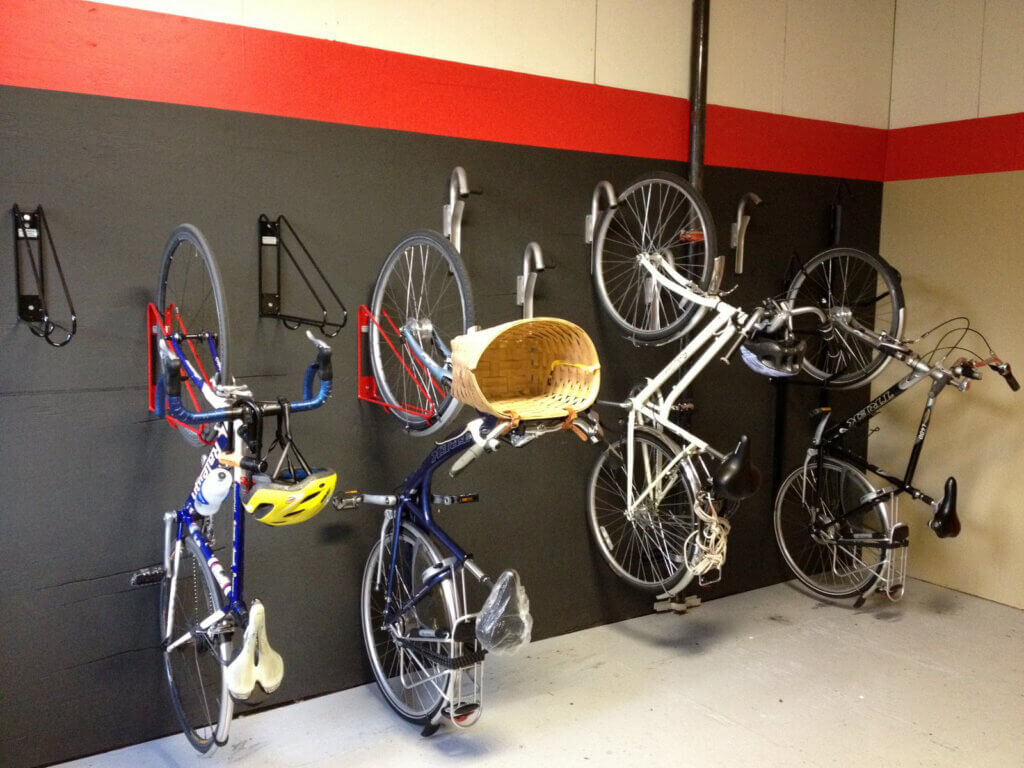
Designing a successful indoor bike room involves careful planning and consideration of various factors to ensure it meets the needs of users. Incorporating a combination of features and characteristics that prioritize security, accessibility, functionality, and user experience is key. Here are some considerations for creating a well-designed indoor bike room:
Location
- Entrance Proximity: The bike room should be strategically located near building entrances or commonly used pathways and designed to comply with accessibility standards to accommodate users with disabilities.
- Ample Space: Ensure the design accommodates the anticipated number of bicycles without overcrowding. The bike room space must be sufficient for the number and nature of bikes to be stored, the types of racks and lockers to be used, and the desired amenities in the room.
- Clear Heights: An ideal indoor bike room will be located in an area with minimum clear heights of 96 to 102 inches to allow for both staggered vertical racks and double-tier horizontal racks.
Security
- Robust Access Control: Bike rooms that have secure access control systems such as electronic key cards, PIN codes, or secure entry mechanisms to ensure that only authorized users can enter the bike room.
- Clear Sight Lines: Good indoor bike rooms should have clear visibility throughout the room. Blind corners and areas with only one avenue of egress (doors in/out) may make some users feel unsafe.
- Multiple Aisles: Incorporate multiple aisles in the bike room configuration so users have a choice of paths to and from their bikes. This reduces potential congestion and damage while promoting safety and security.
- Individual Locker Security: Indoor bike rooms that also offer individual bike lockers increase security and storage for high-value bikes and e-bikes. Consider using double-tier bike lockers for high-density secure bike parking.
- Surveillance: Install surveillance cameras or security systems to deter theft and vandalism. Visible security measures provide peace of mind to users.
- High-Quality Locking Mechanisms: Use strong and tamper-resistant locking mechanisms for both the room and individual storage spaces.
- Make sure all storage solutions provided offer locking, and two points of contact with the bike frame.

Space Optimization
- Efficient Layout: Maximize space efficiency by carefully planning the layout to accommodate the expected number of bicycles while allowing for easy access and maneuverability.
- Staggered Storage: Vertical, horizontal, and double-tier bike racks should provide staggered storage of bikes. This allows higher-density bike parking and offsets for handlebar clearance.
- Accessible Pathways: Routes to and from the bike room should be well-lit and easily accessible, avoiding stairs, narrow hallways, and tight corners that represent obstacles and discourage bike room use. Doors to indoor bike rooms should be at least 36 inches wide, and any corridor at least 54″ wide though 72″ is advised. If stairs cannot be avoided, include a stair access ramp to allow easier movement of bikes up and down the stairwell.
- Angled Parking: Consider using angled bike parking racks and mounts to increase aisle widths when needed.
Storage Solutions
- Secure and Well-Designed Bike Racks: Select sturdy and well-designed bike racks or storage solutions that securely hold bicycles in place and prevent damage. All racks should allow the bike’s wheel and frame to be easily secured to the bike rack.
- Variety of Storage Options: Offer a variety of storage options, such as vertical racks, wall-mounted racks, or floor-mounted racks, to cater to different bicycle types and user preferences.
- Fat Tire and Fender Racks: A portion of bike room racks should also include fat tire bike racks and fender racks. Since both racks can hold standard bikes as well, we recommend diversifying types of parking by 20%.
- Large Bikes: Great bike rooms will have secure parking options for a wide variety of bikes. Be sure to include appropriate storage and pathway options for extension, cargo, and recumbent bikes, and bikes with trailers.
- High-Density Racks: Racks such as the CycleSafe OctoRack and Quad Hi-Density Bike Rack provide user-friendly high-density bike room storage.
- Consider the Capabilities of All Users: Include instructional signage on how to place bikes into a vertical position and how to load bikes. Even still, not everyone will be able to lift bicycles into vertical and upper-tier bike racks. Be sure to also include easy-to-use horizontal bike racks. Good bike rooms have options for all users.
- High-Security Storage Options: Consider incorporating additional high-security storage within the bike room for high-value bikes and those desiring additional security. This can be done by adding an adjacent or internal room with additional access control, or by installing secure bike lockers within the bike room.
Networking & Electrical
- E-Bikes: Today’s best bike rooms have ready access to electrical outlets that make e-bike charging easy and convenient. Consider adding plug molds and wall-mounted outlets to already-built bike rooms.
- Chargers and Other Equipment: Make sure there are plenty of other conveniently placed outlets for cyclist’s power and charging needs, including phones, watches, headphones, navigational accessories, and tire pumps.
- Network Cabling: Ensure your bike room design includes appropriate network cabling for WiFi, door locks, access control, security cameras, TVs, monitors, and any other network devices, such as temperature and humidity monitoring.

User-Friendly Amenities
- Benches and Seating: Include benches or seating areas to allow users to sit while securing their bicycles or making adjustments.
- Bike Repair Stations: Add bike repair stations equipped with tools, pumps, and workstations for users to perform minor maintenance or repairs.
- Air Pumps: Install public air pumps to allow users to conveniently check and inflate their tires. Wheel chocks are helpful to hold bikes up while pumping tires.
- Bottle-Filling Stations: In addition to drinking fountains, be sure to incorporate a bottle-filling station with filtered refrigerated water. Cyclists will love it, and it’s good for the environment.
- Bike Wash Stations: Bikes often need to be cleaned after use. Providing dedicated space and water for bike washing will help keep the bike room clean and will be greatly appreciated by cyclists.
- Personal Lockers: Install personal lockers in the bike room for helmets, shoes, clothes, and other gear. These lockers could be both for short-term day use and be rented for long-term storage.
- Restrooms and Showers: Consider incorporating restrooms and showers in or adjacent to the bike room.
Lighting and Aesthetics
- Adequate Illumination: Ensure proper lighting within the bike room to enhance safety and security. Use energy-efficient LED fixtures with motion sensors or timers to conserve energy when the room is not in use.
- Harmonious Design: Select materials, colors, and design elements that complement the overall look and feel of the building or location.
- Attractive Appearance: Strive for an aesthetically pleasing design that encourages cyclists to use the room.
- Branding Opportunities: Don’t create a plain gray box. Use the walls and surfaces to incorporate color, branding, and messaging. Create a fun space that cyclists want to use.
- Artwork: Incorporate artwork and other elements of visual interest to make the space appealing.

Signage and Information
- Signage: Use clear signage to guide users to the bike room, how to rent space, how to use the different parking equipment and accessories, and communicate any rules or regulations.
- Information Boards: Use information boards to display local cycling routes, maintenance tips, and any rules or regulations related to the bike room. Allowing cyclists to also post information can help promote community.
- Lockers can have display panels added to easily display wayfinding or rental information, or classic advertising.
Maintenance and Cleaning
- Surfaces: Design the bike room with easy-to-clean walls and floors to simplify maintenance. Keeping the space clean will encourage repeated use.
- Wall Guards: Consider installing wall guards with wall-mounted vertical racks to reduce cleaning times and minimize wall marring. Using guard plates will protect bike room walls from tire marks.
- Floor Drains: A good indoor bike room will have one or more floor drains so the room can be washed periodically.
Compliance and Regulations
- Ensure the bike room design complies with local building codes, safety regulations, and other relevant legal requirements.
Future-Proofing
- Consider future needs and technologies when designing the bike room to accommodate potential changes in bike storage solutions or security systems. This may include room for future expansion and raceways for future network cabling and electrical.
Great indoor bike room design combines numerous features and characteristics to create a secure, convenient, and user-friendly space that promotes cycling as a sustainable and healthy transportation option while ensuring the safety and security of bicycles.
When you’re considering designing your indoor bike room or retrofitting an existing bike room for today’s cycling community, get in touch with one of our bike room design specialists. We’re here to help.

